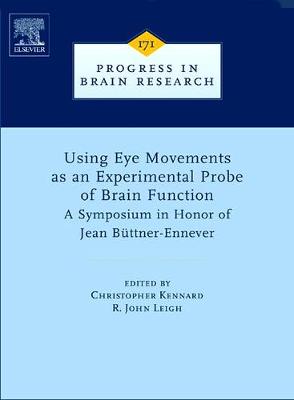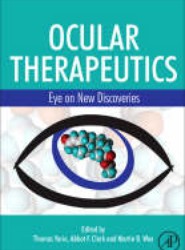(To see other currencies, click on price)
MORE ABOUT THIS BOOK
Main description:
This volume of Progress in Brain Research is based on the proceedings of a conference, "Using Eye Movements as an Experimental Probe of Brain Function," held at the Charing Cross Hospital Campus of Imperial College London, UK on 5th -6th December, 2007 to honor Professor Jean Buttner-Ennever. With 87 contributions from international experts - both basic scientists and clinicians - the volume provides many examples of how eye movements can be used to address a broad range of research questions. Section 1 focuses on extraocular muscle, highlighting new concepts of proprioceptive control that involve even the cerebral cortex. Section 2 comprises structural, physiological, pharmacological, and computational aspects of brainstem mechanisms, and illustrates implications for disorders as diverse as opsoclonus, and congenital scoliosis with gaze palsy. Section 3 addresses how the cerebellum transforms neural signals into motor commands, and how disease of such mechanisms may lead to ataxia and disorders such as oculopalatal tremor. Section 4 deals with sensory-motor processing of visual, vestibular, somatosensory, and auditory inputs, such as are required for navigation, and gait. Section 5 illustrates how eye movements, used in conjunction with single-unit electrophysiology, functional imaging, transcranial magnetic stimulation, and lesion studies have illuminated cognitive processes, including memory, prediction, and even free will. Section 6 includes 18 papers dealing with disorders ranging from congenital to acquired forms of nystagmus, genetic and degenerative neurological disorders, and treatments for nystagmus and motion sickness.
Contents:
Section 1: Using Novel Techniques to Define the Neural Substrate for Eye Movements
Jean Buttner-Ennever, Munich: Re-mapping the oculomotor system
Joseph Demer, Los Angeles: Using high-definition MRI to re-define the mechanics of eye rotations
Michael Goldberg, New York: The cortical representation of oculomotor proprioception
David Zee, Baltimore: How new knowledge of the anatomy of the eye muscles and their innervation translates into improved treatment of patients with ocular motor palsies
Paul Knox, Liverpool: Testing the influences of extraocular proprioception in humans
James Sharpe, Toronto: Reinterpreting palsies of the ocular motor nerves
Dominik Straumann: New insights into trochlear nerve palsy
Paul May: Anatomical insights into peripheral gaze control
Louis Dell'Osso: How disrupting ocular proprioception can be therapy for congenital nsyatgmus
Section 2: New Insights into Brainstem Generation of Ocular Motor Commands
Anja Horn, Munich: New insights into the circuitry and pharmacology of the brainstem reticular formation
Edward Keller, San Francisco: Using multiple electrode arrays to map moving fields of neural activity in the superior colliculus
Paul Gamlin, Birmingham: Synthesis of vergence control by brainstem circuits
Holger Rambold, Lubeck: Disturbances of vergence and saccadic eye movements by human brainstem lesions
Christoph Helmchen, Luebeck: Understanding how the cerebellar disease could cause saccadic oscillations
Stefano Ramat, Pavia: A brainstem network that accounts for abnormal saccades
Mark Gibson, Belfast: Human saccadic disorders and their brainstem mechanisms
Richard Clement: A black-box approach to saccadic disorders
Section 3: Using Eye Movements as an Index of Transformation of Signals by the Cerebellum
Stephen Highstein, St. Louis: How the cerebellar transforms sensory inputs into motor commands
Albert Fuchs, Seattle: How visual and motor signals interact in the cerebellum
John Stahl, Cleveland: How mutant mice with calcium channel defects provide insight into the cerebellar role in balance
Michael Strupp, Munich: How knowledge about calcium channel disorders translates into treatment of human cerebellar disease
Bernard Cohen, New York: Cerebellar governance of vestibular mechanisms
Mark Walker, Baltimore: Influence of cerebellar nodulus on translational vestibulo-ocular reflex
Ulrich Buttner, Munich: Control of smooth-pursuit eye movements by cerebellum
Robert McCrea, Chicago: Influence of cerebellum on combined eye-head tracking
Adolfo Bronstein, London: Degenerative disorders that affect the cerebellar control of eye movements
Section 3: Using Eye Movements as a Probe of Sensory-Motor Processing
Frederick Miles, Bethesda: How the brain uses visual motion as we move through the environment
Peter Hoffmann: How motion signals are encoded in visual areas
Michael Mustari, Atlanta: How disturbed maturation of visual motion processing leads to nystagmus in infancy
Thomas Brandt: How vestibular and visual inputs may be abnormally processed in cerebral cortex
Richard Abadi, Manchester: Visual perceptions during ocular oscillations
Michael Gresty, London: Self-motion, gaze control and visual perception
Bernhard Hess, Zurich: Understanding interactions between responses to head rotations and translations
Michael Halmagyi, Sydney: Probing otolith-ocular reflexes using novel stimuli in humans
Sergei Yakushin, New York: How visual inputs from subcortical pathways influence perception of self-motion
Section 4: Using Eye Movements as a Probe of Cognition
James Lynch, Jackson: Concepts of the contribution of cerebral cortex based on new anatomical findings
Kikuro Fukushima, Sapporo: Prediction, eye movements, and the frontal lobes
Rene Muri, Bern: Using transcranial magnetic stimulation to probe decision-making and memory
Parashkev Nachev, London: Using functional imaging to during conflict resolution and free choice
Charles Pierrot-Deseilligny, Paris: Using saccades to probe different forms of memory
Christopher Kennard, London: Role of the supplementary eye fields in countermanding saccades
Masud Husain, London: Using eye movements to probe shifts of instruction set
Graham Barnes, Manchester: Using smooth tracking movements to probe prediction
R. John Leigh, Cleveland, Ohio: Eye movements: The meaning of it all (Epilogue)
PRODUCT DETAILS
Publisher: Elsevier (Elsevier Science Ltd)
Publication date: September, 2008
Pages: 652
Weight: 1680g
Availability: Available
Subcategories: Neurology, Neuroscience
Publisher recommends


